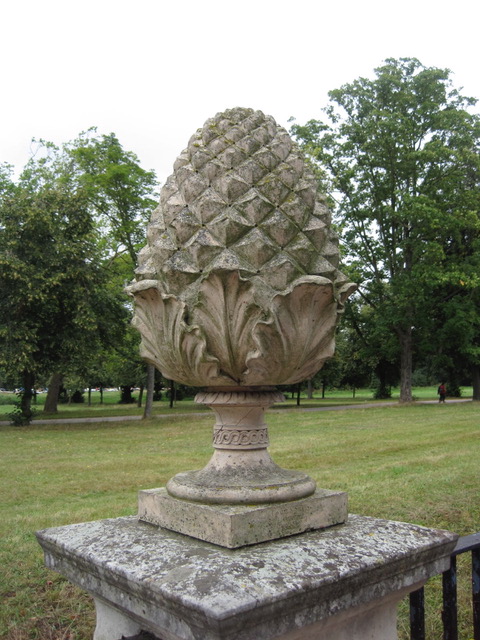As the New Year begins and we surface from the fun and happiness of Christmas parties and family gatherings I started reflecting upon the 16th Century symbol of abundance and hospitality.
Welcoming in the New Year with the ultimate symbol of hospitality.
5 January 2018

Photography by Simon Upton.
The pineapple finial rises as a welcoming symbol. For the past four centuries it has been custom to use on the gate posts of Country houses.

Designed by Eleanor Coade for Ham House in the 18th century, Coade Ltd has created the replica of this original.
The pineapple was introduced to Europe and America by Columbus in the 15th Century when he discovered it in Guadeloupe. The ‘Anana’ – ‘excellent fruit’ ( in Tupi language) became the ultimate symbol of wealth, generosity and ultimate hospitality in the following centuries. In the late 17th Century, King Charles II was painted with a pineapple. The symbol of ultimate privilege.

King Louis XV of France was the first to grow the plant in lower climates and commissioned a hothouse to be built in the grounds of Versailles. A flurry of hothouses followed.
in 1761, John Murray of Dunmore Park, Scotland, commissioned a hothouse with a wonderfully elaborate fourteen meter high finial on its domed roof in the shape of a pineapple. It stands in the entrance of one of the many walled gardens.

The magnificent pineapple of Dunmore Park, Scotland.
Stephen Pettifer, a great friend and creator of Coade Ltd, whom we represent at Jamb, explains the Pineapple Finial is as popular now, as it was then. Indeed, there seems to be an increasing demand and interest for garden sculpture. His tireless commitment to deciphering the unique 18th Century ceramic clay recipe that Eleanor Coade created all those centuries ago took him twelve years.
It is extraordinary to think that the legacy of Coade London almost lay forgotten after the 1830’s. Even though there are countless examples of antique Coade all around the world, it is because of Coade Ltd that the great legacy continues and many original 18th century designs can still be bought.

It is fascinating to watch Stephen, and the Coade team which includes the hugely talented Alasdair Rennie and Hannah Hartwell create a piece of Coade sculpture. Working with the unique blend of Devon ball clay, grog and silicas lends itself to a myriad of different sculptural possibilities: from tiny architectural detail to figurative sculpture on a monumental scale. First they have to sculpt the piece in clay before a mould can be taken. With the use of specialist multi-piece plaster moulds, works can be reproduced many times and each piece is then painstakingly hand-finished to the finest degree. When fired the sculpture can withstand the harshest of weather conditions and the worst pollution.

Alas, I don’t have the Country house that I thought I would have when visiting Ragley Hall, aged seven when my delusions of grandeur started. It would be a dream to have some Coade pineapples on a gate post leading to my own Palladian abode! But for now I will make do with enjoying the pair in our London showroom that sit happily amongst our antiques and reproduction designs.



